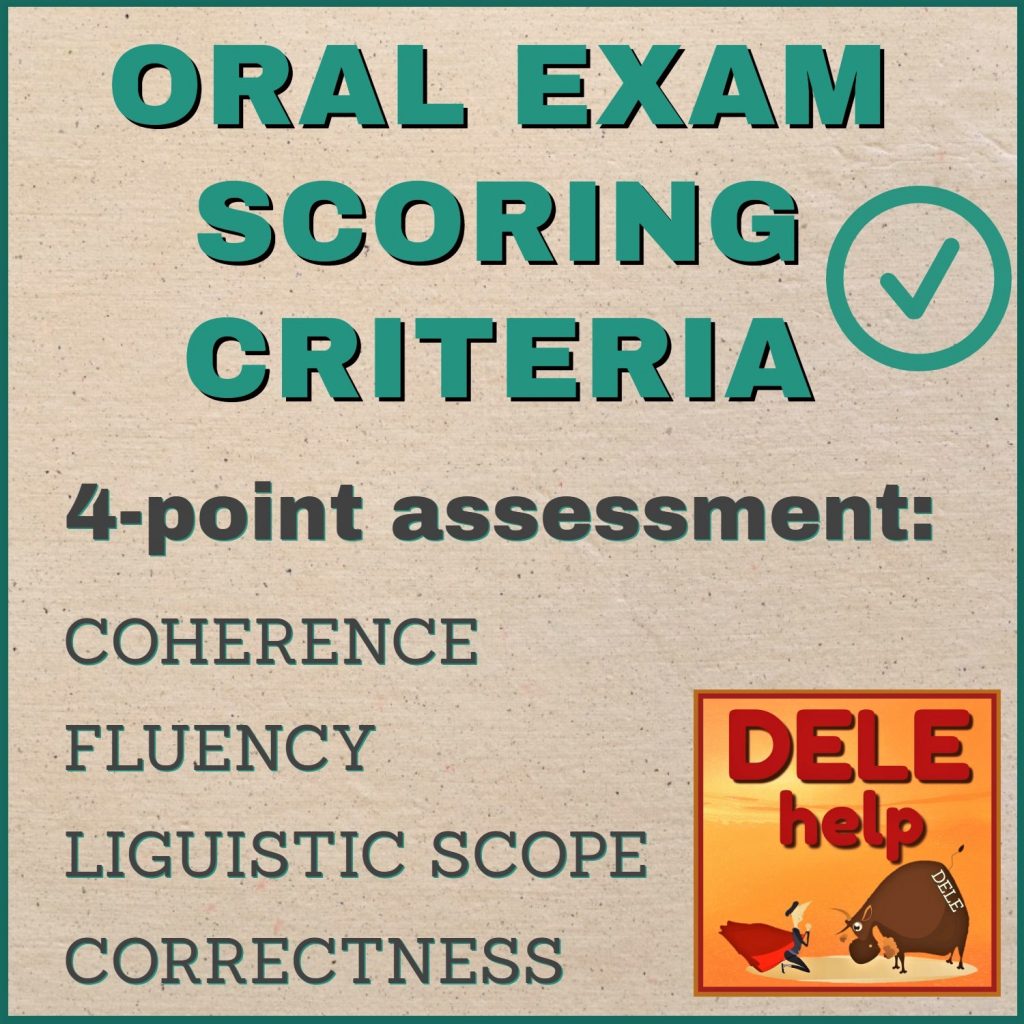Acing your Spanish oral exam: 20 TOP TIPS

Acing your Spanish oral exam, whether it be the American Oral Proficiency (OPI) or the DELE / SIELE exams of the Instituto Cervantes of Spain, present the greatest challenge of all the sections of these exams of your real-world “communicative competency”. Statistics show us that about one-third of candidates fail the DELE Spanish language exams they entered for. Of these unsuccessful candidates, 70% failed the diploma exam because of having failed the DELE’s oral expression section. What do you need to know, and skills do you need to practice, so that you can do well in your Spanish exam’s oral expression test? How best can you prepare for this challenge? Here are our battle-tested 20 TOP TIPS.
(Note: Since these exams are all based on the principles of the Common European Framework of Reference for Languages (CEFR), for the sake of convenience and brevity we will henceforth refer by name only to the DELE, thus standing for the conjoint of Spanish exams, unless we need to mention one specifically; in other words, the tips below apply to them all).

1. Know what the didactic goals are of the oral exam.
These exams test your ability to communicate orally in everyday situations. There’s no more common, nor more essential way of communicating, than by means of speaking. This makes the oral expression task obviously crucial in assessing your overall communicative competency. So, what is the level of communicative ability that the DELE examiners desire at each of the different levels, from A1 through C2? You can study the policy statements of the Cervantes Institute and / or the European Union’s “Common European Framework of Reference for Language” (DELE is the Spanish iteration of the latter). Or, if you don’t want or can’t plough through these long documents with their high academic language (in Spanish): simply ask for our free 96-page DELE / SIELE Exam Orientation and Acing Tips handbook, which will show you all you need to know, in plain English. Just click on the book promo image lower down, to ask for it – FREE and with no obligation to sign up for tuition.
2. Know the assessment criteria & scoring system.
You need to be familiar with the system and criteria that the examiners will be using to assess your oral expression performance. If you don’t know what they are actually looking for, you won’t know how best to make your presentations or how to most effectively converse with your interviewer. Our DELEhelp study material include actual audio clips of oral expression exam candidates who passed and who failed, together with the examiners’ comments. We also have included the full official assessment criteria, translated into English, of both of the two scoring scales used, namely the holistic scale and the analytical scale. Again, these are all covered in our FREE DELEhelp Workbook #9.2 : DELE / SIELE Exam Orientation and Acing Tips (which is available as a download in .pdf format – see book promo image at end of this post – or click on this LINK).
3. Read out loud when you practice.
Whenever you are reading Spanish books, blogs or news media during your self-study and relaxation hours, read out loud. As preparation and practice of your pronunciation, do as much of your Spanish reading en voz alta, so that you can get accustomed to actually saying words, not just seeing or thinking them.
4. Record your practice sessions, preferably on video
When you do simulations of oral presentations with your coach, record yourself on video (Skype, which we use for our online coaching, has the appropriate feature for this). That way you can hear and see yourself in action, and can take note of improvements you need to make. (The key, of course, is to have access to an expert, 1-on-1 tutor to simulate the exam interviews with, to guide you and give you feed-back – oral practice is the one component of exam prep that you can’t effectively do on your own, by your lone-self).

5. If possible, do the oral the day before the written exam
If you are given such an option by your exam center administrators, try to do the oral test when you will still be at your freshest. Try also to be the first candidate to be examined on the day, so that the examiners also can be at their freshest, without yet having established a very high bar due to some genius who had gone before you (remember, this part of the exam is scored in real time, there at the exam center, by two examiners sitting with you).
6. Read (and re-read) the instructions with great care.
At the start of the oral exam, you will be given the exam paper and time to prepare. Carefully study the guidelines – they contain clear guidance about what is expected of you, which topics you need to address in your oral presentation, what the contextual setting is of – for example – the photo you have to discuss, etc.
7. Plan your presentation, giving it a clear structure.
Pay particular attention to coherence, as well as to your introduction and especially the conclusion. The guidelines for examiners oblige them to score each task immediately after delivery. Accordingly, your concluding statement will form their last impression and should therefore be as good as you can make it – neatly tying together your main points and the conclusions you have reached.
8. Sit correctly
Before the oral interaction tasks, you will be introduced to your two examiners. You will be seated at a small table, opposite the examiner acting as your interviewer (who also does the holistic assessment). The other examiner (doing the analytical assessment) will be seated behind you. When sitting down, don’t slouch (i.e., don’t sit with your head and upper torso leaning back in relation to your backside). Not only does this posture constrict your breathing, it looks bad and it sends the signal that you don’t relish engaging with your interviewer.
Sitting correctly means getting your lower backside as far into and pressed up against the chair’s backrest as possible. This will help with your breathing and articulation. It will also force your upper body forward, thus into a natural posture of engaging positively with your interlocutor. (The initial minute or two, before you are invited to launch into your oral presentation, will be dedicated to a brief icebreaker conversation, usually in the form of the interviewer asking you about your origins).

9. NB: NB: Engage with your interviewer, make and maintain eye contact, smile, be relaxed and friendly, remind yourself to COMMUNICATE.
Make sure that you go into the oral test with the correct mind-set, focused on demonstrating your ability COMMUNICATE: to engage in conversation and convey a coherent message with fluency, thanks to having acquired a sufficiently ample linguistic scope (lexis) as well as ability to use the Spanish language with accuracy in relation to pronunciation, intonation and its grammatical patterns. (We will now describe in more detail the four assessment criteria that examiners use, which are equally weighted – i.e., each counts for 25% of your total score).
10. Acing your Spanish oral exam: FLUENCY as criterion.
Fluency is achieved through guided practice, practice, practice, and through having a sufficient lexis (pf vocabulary, collocations, link phrases and expressions) at the tip of your tongue. Particularly important is using link phrases (connectors / cohesive devices), for which the examiners will be actively looking in your discourse. It is therefore important to know and practice a list of such link phrases which you can employ naturally. Your lexis or “linguistic scope” must be such that the right words / phrases and expressions will roll fluently off your tongue, pronounced correctly.
However, it is critical not to get hung up in the heat of the exam on searching desperately for specific words that may have momentarily abandoned you; use whatever others that come most readily to you at that moment, even if you also have to use hands, face and additional description to communicate your point. The key to fluency remains practice, practice, practice – you have to internalize the patterns and lexis of the language with the help of an expert 1-on-1 tutor.
11. Acing your Spanish oral exam: COHERENCE.
Having a logically coherent message expressed with cohesive phrases, is another key scoring criterion. Your message must be well structured and organized logically, so that your meaning can be clear. Once again, the effective use of link phrases is key to logical coherence and to the necessary cohesiveness of your sentences, in order to avoid fragmented, disconnected ideas and phrases.
In the time given to you to read the exam paper and prepare your presentation, decide on an appropriate structure and note it down bullet-style (you may consult your notes, but not read entire phrases verbatim from it).
Be sure that you have understood the task given to you. Read the instructions and questions very, very carefully, otherwise you may miss the point and appear incoherent.
The key segments of structure will be your introduction and conclusion – give particular attention to these.
The oral exam tasks are intended to be REAL communication: they are all about conveying information and meaning, thus clarity of message. Remember that COHERENCE and FLUENCY count for 50% of the overall oral exam weight, so don’t get fixated on accurate grammar, at the expense of being fluent and coherent.

12. Acing your Spanish oral exam: LINGUISTIC SCOPE.
Lexis is the third of the four oral scoring criteria. This means your repertoire, your knowledge of words (vocabulary) and of regular “chunks of words” (collocations), link phrases and idiomatic expressions which together make up what we call lexis.
We believe that acquiring an ample lexicon is the best single thing you can focus on in your overall exam preparation – not only because it counts for 25% of the oral mark (and clearly influences your ability to be fluent and coherent as well), but because it is essential for the listening and reading comprehension tests. You can imagine the difficulty, if you simply don’t comprehend the meaning of key words in the comprehension tests!
13. Acing your Spanish oral exam: ACCURACY.
Correct language use is the last of the four equally-weighted scoring factors. This relates to correct pronunciation as well as using the correct patterns of phrase construction – i.e., accurate grammar, such as agreement of gender and number.
However, you need to be aware that the examiners are under strict instructions to ignore small grammar mistakes that do not impact the clarity of your message (in other words, this is not a school / college-style exam fixated on grammar).
If you realize that you’ve made a mistake, correct yourself in a natural manner, don’t try and ignore it as if it didn’t happen – you will actually be positively assessed for having corrected yourself.
It always impresses to bring the Subjunctive mood into your discourse, which you can usually do with ease by developing and learning a stock phrase or two which you can drop into the initial “icebreaker” conversation or your introduction, or in the conclusion (something like: “Ojala pueda mantener esta pretensión de estar relajado por los próximos 15 minutos!”)

14. Confirm questions, if needed.
It’s certainly normal to get nervous in an exam situation. It is therefore normal (as normal as it is, also in real everyday conversations) that one may need to ask the interviewer to clarify a question. Rather ask, than try and answer a question that you’re not sure about and may have misunderstood – it will be far more damaging to talk completely off point, than it would be to appear human and ask. So, make sure to ask the interviewer to repeat, or to clarify the question if in any doubt, with a phrase like “Puede usted explicarme su pregunta, por favor…”
15. Personalize and engage with the content.
It is viewed positively if you can incorporate and reflect your own perceptions and opinions about the subject matter, for example by quoting relevant personal experiences. Don’t just recite back, in a purely descriptive manner, the elements of the content you have been provided with.
16. Cover all the elements set in the task description.
The exam paper will indicate what is expected of you (these aren’t “gotcha”-type exams). Make sure that you include the points required to be covered by you, in the scheme of structure you jot down when you prepare your presentation, and that you do address each of these points.

The scoring system used in calculating pass or fail in your DELE exam ORAL test is explained in this blog post
17. Watch the clock.
The most important time-related risk in the oral, is that of not speaking for the totality of the required amount of time. So see to it that, in the the conversational parts of the oral (i.e., the question-and-answer and debating tasks) you speak until the interviewer tells you to stop. (In the SIELE and OPIc, you will see the time remaining indicated visually, on screen). On the other hand, in the monologue tasks such as your initial prepared presentation, it is of course possible to go seriously over time. This may harm your clarity and coherence, because you will likely be cut off before you’ve arrived at your conclusion.
Don’t miscalculate your structuring and dwell on your first points for so long that you don’t get to cover the other main points nor conclude in a satisfactory manner – in prior practice, get a clear idea of how long you typically speak to each of your bullet points.
Therefore, plan the structure of your message well and have a watch sitting next to your notes in front of you in the DELE oral, so you can pace yourself (remember to bring an old-fashioned watch with you, because you cannot have your smartphone with you in the exam hall). Don’t be too worried about going over time in the conversational section – your interlocutor will stop you once enough is enough.
18. Learn to consult your notes in a natural manner.
Don’t try and hide them, and neither should you set them so far off to your side that it would require you to disengage with your interlocutor in order to look at them. The best is to keep them in front of you, in direct line of sight with your interlocutor, thus allowing you to maintain maximum eye contact. Don’t feel shy about using them or try and hide that you are consulting your notes; you can be quite open about consulting them, if done naturally and briefly.
Make your notes part and parcel of the conversation – it enhances your confidence to know that you have them, and thus your authoritativeness. However, the one big no-no is slavishly reading verbatim whole sentences that you had prepared (it’s actually good to have your notes quite open, so that the examiner will see that they consist of no more than a bullet-point scheme). The key to success is practicing to consult your notes in such a natural, non-disruptive way that doing so actually enhances the flow of well-structured conversation, rather than detract from it.
19. Pay attention to your delivery, i.e., the art of oratory.
Vary your tone and emphasis, to underscore key points. Don’t be so hung up on ensuring correctness of your grammar that you lose the natural flow, rhythm and thrust of conversation as interactive, interpersonal engagement. SMILE. Remember that the examiners are taught how to, in a friendly manner, draw you out of your shell, and never to correct or criticize you – therefore, relax: they are not your enemies, nor your inquisitors.
20. Confidence is the key to fluent, engaged conversation.
When you listen to the audio clips of actual oral exams, passed and failed (linked to in our FREE exam prep book), you will notice that the failed candidates often didn’t possess significantly weaker linguistic skills than those who passed. The big difference is that the unsuccessful ones allowed their evident lack of self-confidence to rob them of the skill of natural communication.
Never forget that these oral exams test your capacity to communicate effectively – to receive and transmit meaning. And the best booster of confidence, is the knowledge that you have practiced and practiced and practiced doing these oral interactions to perfection, doing as many guided simulations as possible in the weeks and months leading up to the exam, with your expert 1-on-1 coach. Practice truly makes perfect, because oral expression is first and foremost a SKILL, not merely an abstract academic knowledge set.
Following our proven 1-on-1 coaching methodology, based on a thorough initial diagnostic of your existing level plus your individual strengths and weaknesses, and then developing a personal study plan tailored to YOUR needs, is the battle-tested best way of preparing yourself for acing your Spanish oral exam (and your exam in general).





Realmente interesante y útil. Esperamos ver más.
I would like to see your free Workbook on the DELE curriculum and exam scoring criteria. Thanks for offering them gratis.
Yes, I’m also interested in this workbook you’re giving away free.
Very helpful advice, thank you!
Great recommendations, will definitely put them to use.